As wells dry up and lawmakers balk, Cochise voters could force new groundwater protections

Viridescent fields sprawl along stretches of rural roadway, creating an oasis in a desert landscape. The scent of flowering grapevines and freshly turned soil filters through the air in a part of Cochise County where farming is a way of life for many.
Approaching Kansas Settlement Road, the scents begin to dissipate, replaced by the smell of cow manure and fertilizer. Thousands of cows press tightly together, munching on mixed grains and hay. Tractor trailers barrel down cracked roadways and pass by center-pivot irrigation equipment hoisted above newly cultivated acres.
Ahead is Riverview LLP’s Coronado Farms, a Minnesota-based mega-dairy that has been scooping up land here over the last few years.
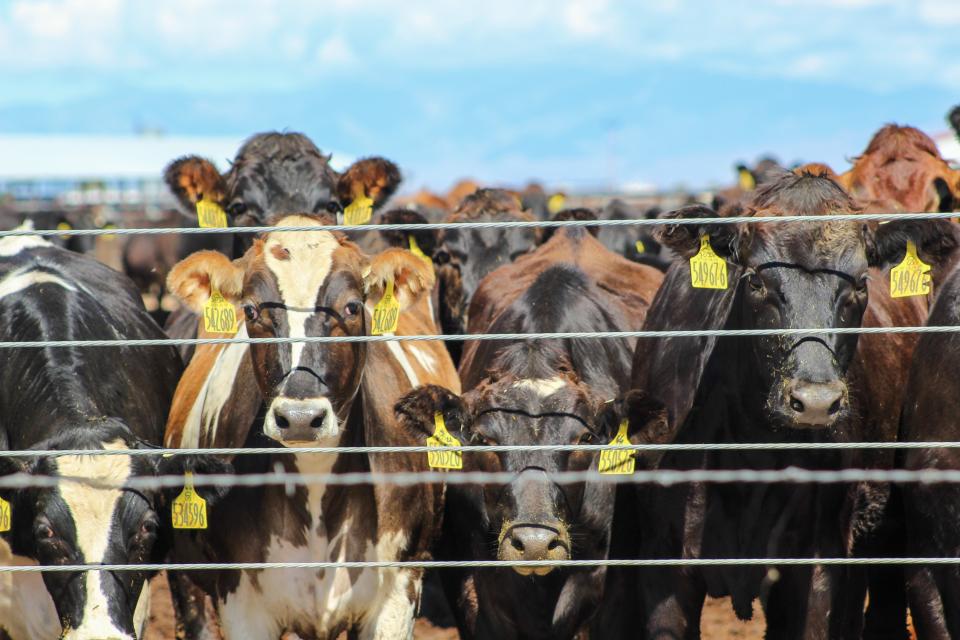
Large-scale dairy farms from the Midwest and nut growers from California have moved into the region and expanded, lured by the cheap land and lack of regulation that allows growers to drill deeply into the area's aquifers.
This is the wild west for groundwater pumping in a fast-growing state already strained by a 22-year mega-drought.
But the November election could rein in some of the largest water users. Voters in parts of Cochise and Graham counties in the southernmost part of the state are voting on a proposal, known as Proposition 420, that would manage groundwater using a 1980 law that has so far applied mostly to development in urban areas. Residents collected signatures to put the measure on the ballot after the Legislature refused to act.
Those who support the creation of an Active Management Area say it is the best way to control the overpumping of groundwater and the rapid expansion of mega-farms that are now common in the Willcox and Douglas water basins.
A 2020 Arizona Department of Water Resources report found that groundwater levels in the Willcox basin dropped 8 feet a year in some areas from 2008 to 2018. A 2018 report estimated that at least 180,000 acre-feet — that’s roughly 58.6 billion gallons — were drawn out of the aquifer annually from 1995 to 2015.
Opponents of the proposed rules say they do not want the state to control their private property, although the state does not recognize groundwater as private property, which allows management steps. They also stand firm on the position that the AMA would have negative effects on the economy of a region that relies heavily on farming.
But supporters of the measure say groundwater depletion is already hurting the economy as the values of homes with no water plummet. Residents have abandoned their properties, unable to afford new wells, and sought life outside the basins. They have taken with them their jobs, spending dollars and taxes. Cochise County’s population declined by 4.5 percent from 2010 to 2020.
Amid the debate, people on both sides seem to agree that something, whether an AMA or an alternative management plan, needs to be done to control over-pumping in the basins.
If voters reject the AMA and cannot find an alternative to manage groundwater, experts say more wells will be at risk of running dry and the ground in the area, already riddled with fissures and areas of subsidence, will sink at unprecedented rates as it has been since the 1960s.
“There's just no control, no regulation,” said Cheryl Knot of the Arizona Water Defenders, the group that helped put Proposition 420 on the ballot. “It’s a free for all.”
Arizona's Groundwater Management Act
In 1980, Arizona was trying to secure funding for the Central Arizona Project Canal to bring in water from the Colorado River for future growth. But the federal government wanted the state to better manage its groundwater first.
Kathleen Ferris, a senior research fellow at the Kyl Center for Water Policy at Arizona State University, was the executive director of the Arizona Groundwater Management Study Commission and helped write the 1980 Groundwater Management Act.
She said the committee was pinned against a deadline set by the then-Interior Secretary Cecil Andrus, which is one reason why rural areas were left to fend for themselves when it comes to water use.
Andrus threatened to withhold federal funding from the Central Arizona Project if the legislation was not drafted and passed by the summer of 1980. Ferris said many residents in rural areas at the time did not want to be cut into the deal.
The CAP Canal was designed to deliver Colorado River water to Maricopa, Pinal and Pima Counties, home to more than 80 percent of the state’s population.
After months of work by the study committee and legislative leaders, then-Gov. Bruce Babbitt — who would go on to serve as Interior Secretary under President Bill Clinton — signed the landmark Groundwater Management Act. It created a system to manage groundwater in five regions of the state where overpumping was most severe and aquifer levels were declining the fastest.
Areas with heavy reliance on mined groundwater were identified and designated as Active Management Areas. The five AMAs — Prescott, Phoenix, Pinal, Tucson and Santa Cruz — are subject to certain regulations regarding the withdrawal and use of groundwater.
Voters in parts of Cochise and Graham Counties will be asked to create a sixth AMA, with its own set of goals and limits, in the Willcox and Douglas Basins.
Though there are questions about establishing another management area, the Arizona Supreme Court upheld the 1980 Groundwater Management Act, ruling that groundwater is not private property and can be managed by the state as a public resource.
If voters pass Proposition 420, the Department of Water Resources will adopt management goals. Ferris said these goals will be “wide open” to fit the basin's and residents' needs.
An appointed director and five-person groundwater users advisory council would conduct a public hearing on the proposed goals and management plan. Residents within the basin would have an opportunity to speak out during the process.
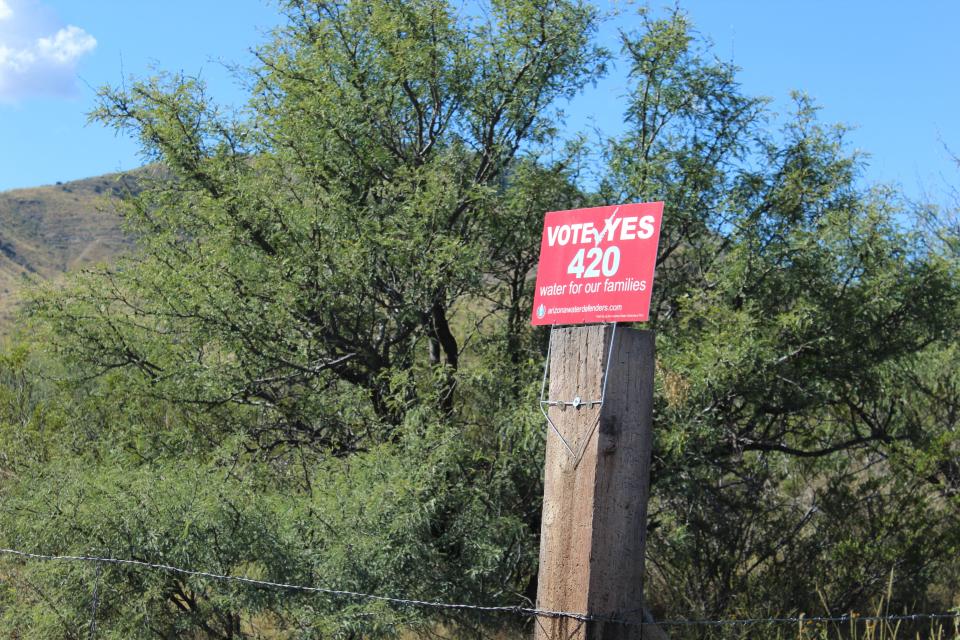
“Those management plans most likely would be based on conservation requirements,” Ferris said. “So they wouldn't say to people, 'you can't pump groundwater anymore.' They would say you have to be more efficient in use of groundwater just like it's happening in the other AMA’s.”
The state has 30 days after designation to set the management goal and a timeline on when it will be achieved.
The main goal in other AMAs is to reach a safe yield by 2025, where the amount of water removed from the aquifer roughly matches the amount replenished. None of the AMAs has achieved the goal yet.
Most residential wells would not be affected by this designation. Wells that pump 35 gallons per minute or less are considered exempt from AMA regulations.
“If somebody is a farmer's market grower and using groundwater on less than two acres drawn from an exempt well, or even not drawn from an exempted well, that is permitted,” Ferris said. “It's when you get over two acres that the law comes into effect.”
Another key component of the AMA is that growers pumping from large wells will have to file annual reports with the Department of Water Resources and document how much water they are using.
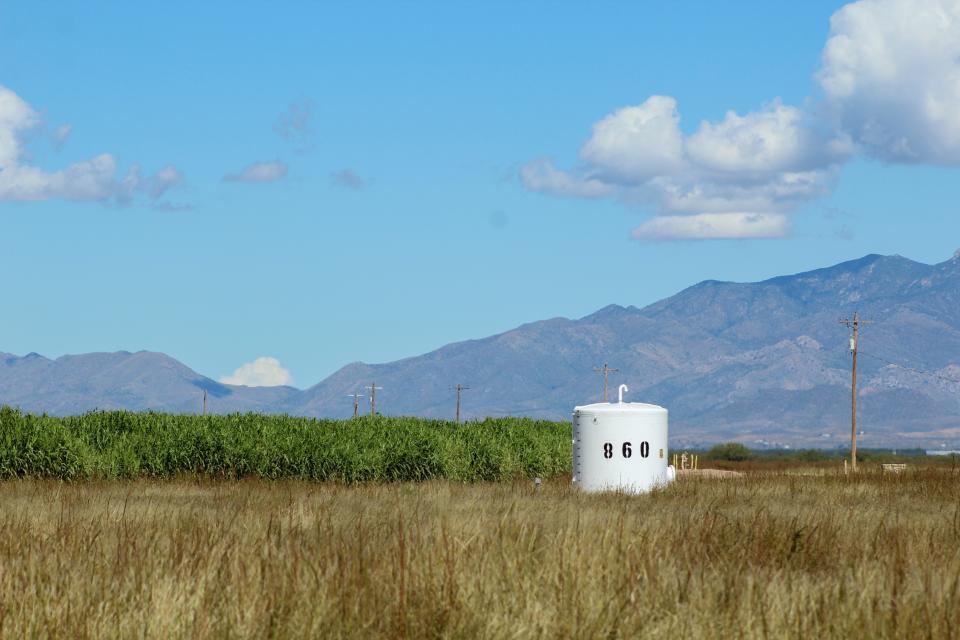
“We need to know in order to manage,” Ferris said. “We need to understand how much groundwater is being withdrawn in order to think about it in a way that we might be able to effect or ensure the sustainability of that groundwater.”
Some believe the influx of large-scale industrial farmers, putting hooves on the ground and planting trees, has sped up groundwater depletion. But since the area is not covered by an AMA, wells are not metered. The large farms do not report water usage to the state, so there is no sure way to track how much water they have drawn out.
But a lot of water is needed to irrigate all the new agricultural expansion in the area. Well drilling records show large-scale farms in the basins own more than 700 wells and have collectively drilled more than 200 wells deeper than 1,000 feet.

“Companies want access to as many natural free resources as they can get,” Knot said. “That increases their profit if they don’t have any restrictions to how much they have access to.”
Riverview LLP began buying land in the Willcox Basin in 2015 and has drilled at least 80 wells there. In 2020, Riverview began buying land in the Douglas Basin and has added multiple wells there as well.
Riverview initially reported around 8,000 cattle on its property. That number has ballooned to over 150,000 cattle split between two properties, Coronado Farms and Turkey Creek, which are just a few miles down the road from each other.
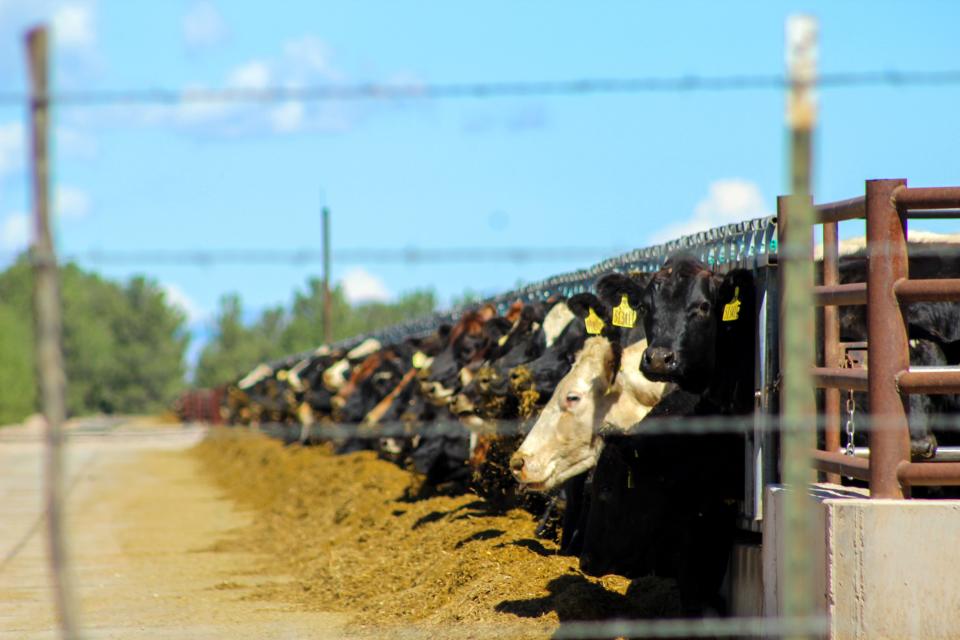
As of 2020, the company has purchased more than 51,000 acres in the Willcox and Douglas basins, according to Cochise County land records, spending more than $180 million. Nearly all of this land was purchased using cash. The company told news outlet Circle of Blue this past spring that it withdraws 110,000 acre-feet of water a year.
An acre-foot is the amount of water needed to cover one acre with one foot of water. An acre is roughly the size of a football field, so Riverview pumps at least 110,000 football fields worth of water every year. Each year that number likely grows as the operation buys more land and produces more cattle.
Riverview has not taken a public position on Proposition 420.
Special report: Megafarms and deeper wells are draining the water beneath rural Arizona
Death of the small farmer
Anastasia Rabin fills a tin cup with water in the kitchen sink of her home, located on 160 acres off a long dirt road in the Douglas Basin.
“Would you like some well water?” she asks. “While you still can get it.”
Rabin lives with her fiancée, two dogs, some chickens, three horses and a pack of goats. She used to operate a small farm but shut down the operation in fear of her water running dry.

She decided that producing food and trying to make a living this way was not sustainable given the conditions of the drought and rampant groundwater depletion.
The land surrounding her property was once owned by local farmers. Today she is on an island surrounded in nearly every direction by Riverview LLP.
She moves her arm like a ticking clock, detailing each neighbor that sold out to Riverview one by one.
“There was this guy who owned over 4,000 acres,” she says pointing to the west over a wire fence. “He was like the big corn guy.”

The corn guy sold his property to Riverview in 2020. She says the process of Riverview buying out her neighbors happened rapidly.
“Once they bought him out it was like the dominos just started falling,” she said. “Once they had that chunk, everybody knew what Riverview was doing would dictate everything around here.”
She points to an empty spot across the road where, just a few months ago, a small home had stood for decades.
“One day they just tore it down and buried it,” she said, her hands on her hips as she takes in her surroundings. “It’s this whole place.”
Rabin considers herself lucky because her well has not run dry — yet. But she believes she will not be able to stay on this property for much longer given the situation.
“Everybody around me has had to deepen their wells,” she said. "People out on Highway 191, my neighbors next door, at the end of my driveway.”
Installing or deepening a well can cost tens of thousands of dollars if not more. And many people here cannot afford the luxury that is water.
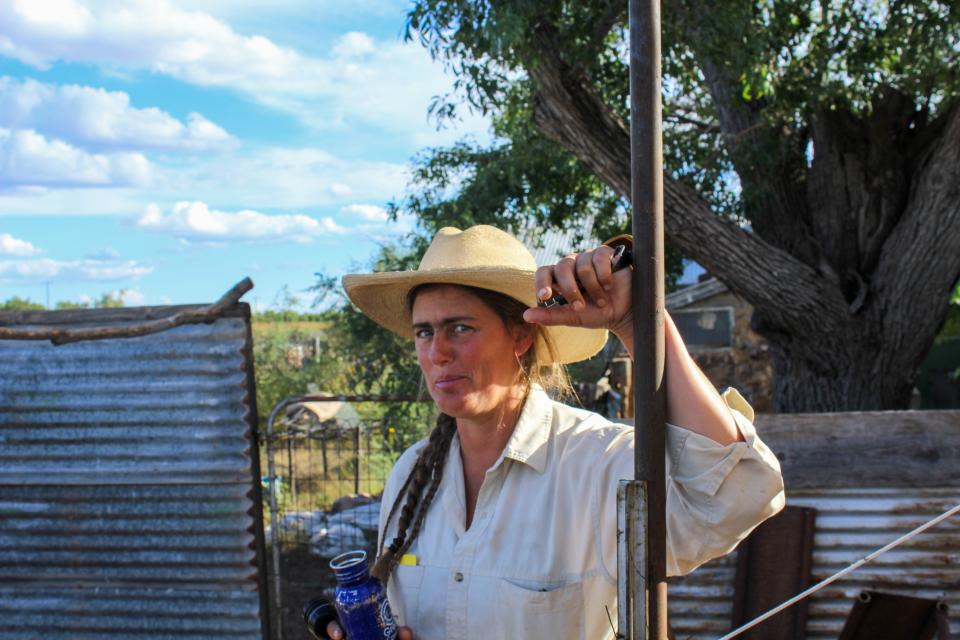
A higher share of people here live in poverty compared to the national and state averages. According to the U.S. Census, more than 14% of Cochise County residents live under the poverty threshold, and the county’s per capita income is $28,021 a year.
“There's a lot of people that have walked away from their property because they couldn’t afford it,” she said. “They couldn't live there without water and their property wasn't worth anything, so they just walked away.”
Getting it on the ballot
In January 2020, Cheryl Knot woke up to find there was no water in her Cochise County home. At first, she thought it was a product of a cold night in the desert.
“I thought, well, I didn't know we were going to have a hard freeze last night,” she said. “Never occurred to me that it was anything other than my pipes being frozen.”

But the well servicing the area had run out of water. A new well had to be installed and for weeks in between, water was hauled in from elsewhere to fill up the existing well.
After a night of watching television news, she realized that other wells in the area were also running dry. She looked around to see what she could do to help the situation. That is how she came across the Arizona Water Defenders.
The AWD is a grassroots organization made up of residents of the Willcox and Douglas basins. The group was successful in getting more than 10% of registered voters in each basin to sign a petition to get the AMA measure on the ballot.
The Douglas Basin currently is covered by an irrigation non-expansion area. INAs prohibit new acres of land coming into cultivation, though land that was irrigated prior to 1980 can continue to be irrigated and wells can be added and dug deeper.
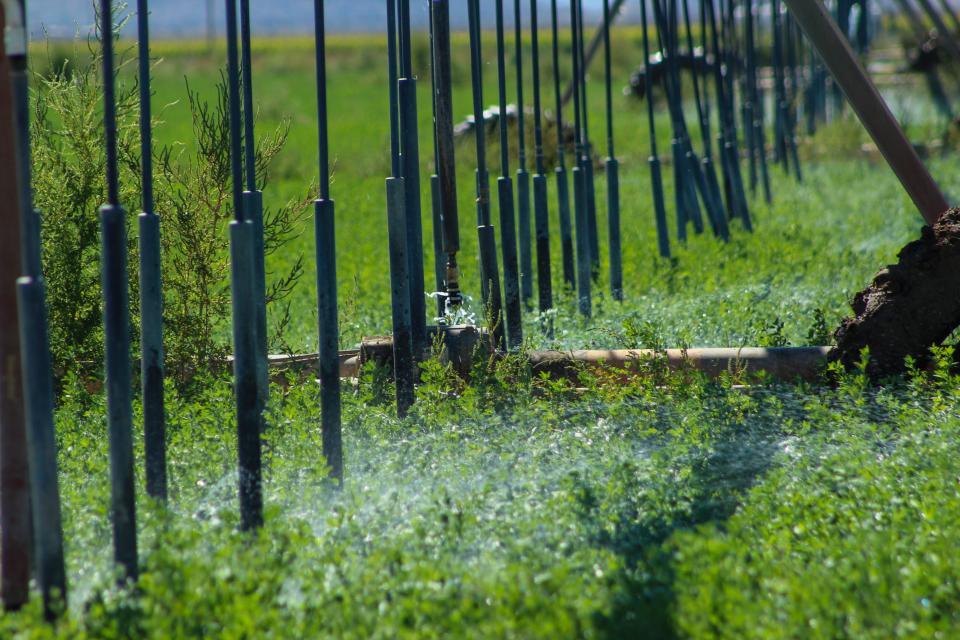
The Willcox Basin does not have the same protection, meaning new land can be cleared and cultivated every year.
More cultivated land means more stress on the already strained water supply. What adds to the strain is the lack of a renewable water source. The area is not served by the Colorado River like some parts of the state, leaving groundwater as the only source.
“We don’t have a river here,” Knot said. “Not even a sickly-dying one.”
An INA does not include any requirements for well spacing, assured water supply, annual reports for measuring withdrawals and does not regulate permits for new big industrial uses.
The area was designated a critical groundwater area as part of the 1948 Groundwater Code. The INA has been in place since the 1980 Groundwater Management Act was passed.
“What that code said was that the state land commissioner could designate areas that where there wasn't sufficient groundwater for the current levels of agriculture,” Ferris said. “All but two of those were included in the original Active Management Area.”
Draining aquifers: Arizona provides sweet deal to Saudi farm to pump water from Phoenix's backup supply
The basins are sinking (and cracking)
Overpumping is also changing the physical landscape. Joseph Cook is a research scientist with the Arizona Geological Survey who specializes in earth fissures. He says the entire area around Willcox playa is sinking.
“From 1969 to present there is an area north of Willcox that is 11 feet lower than it was in 1969,” he said. “The whole valley has sunk to that degree.”
To measure the subsidence, ADWR uses a satellite that bounces light waves off and measures the return time. The agency goes back every six months and can measure differences down to the centimeter.
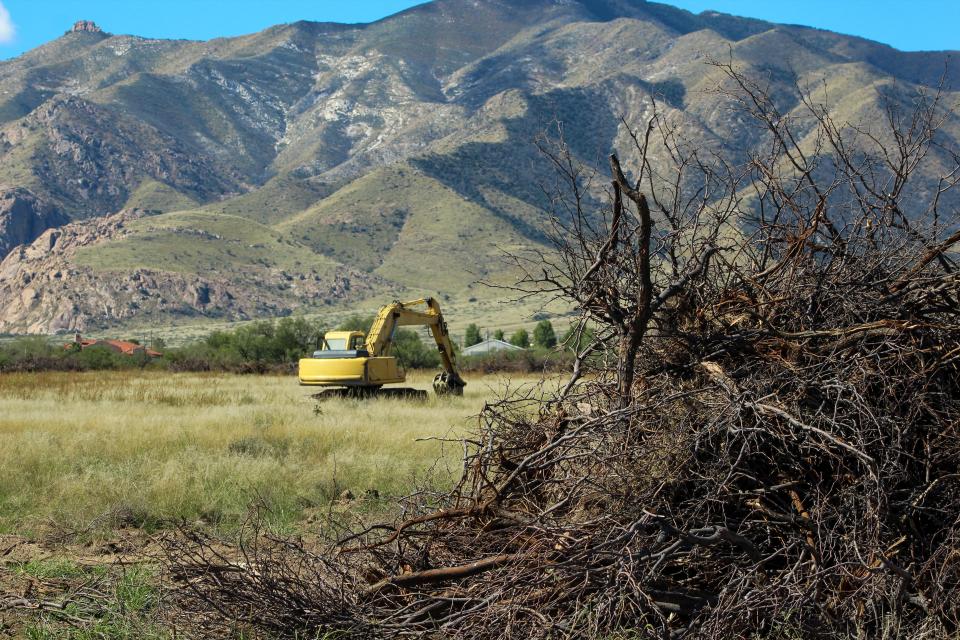
“When you extract enough groundwater from underground, the ground surfaces actually sink,” Cook said. “You end up with these cracks around the edges of where it's sinking.”
The terrain will become uneven when land subsides because it will sink faster on one side. Earth fissures, which are long, narrow cracks in the earth, begin to form and cause disruption.
These cracks are sometimes 10 feet wide and 20 feet deep and can run along the surface for miles.
“The cracks wouldn’t be there without the subsidence,” Cook said. “And the subsidence wouldn’t be there without the overpumping.”
Many times, cracks open in fields far away from homes and businesses. But in recent years, earth fissures have been creeping too close for comfort for some, opening and swallowing parts of local and state roads, making travel in the sparsely connected community even more difficult.
“There was damage to Dragoon Road, Parker Ranch Road and Highway 191, all because there's various types of cracks,” Cook said. “They’re really expensive, destructive process where the cracks go under a road and now it's not safe to drive across that road because there's a literal void underneath.”
Cracks that form on private property can drive down home values significantly and undermine the infrastructure of the dwelling.
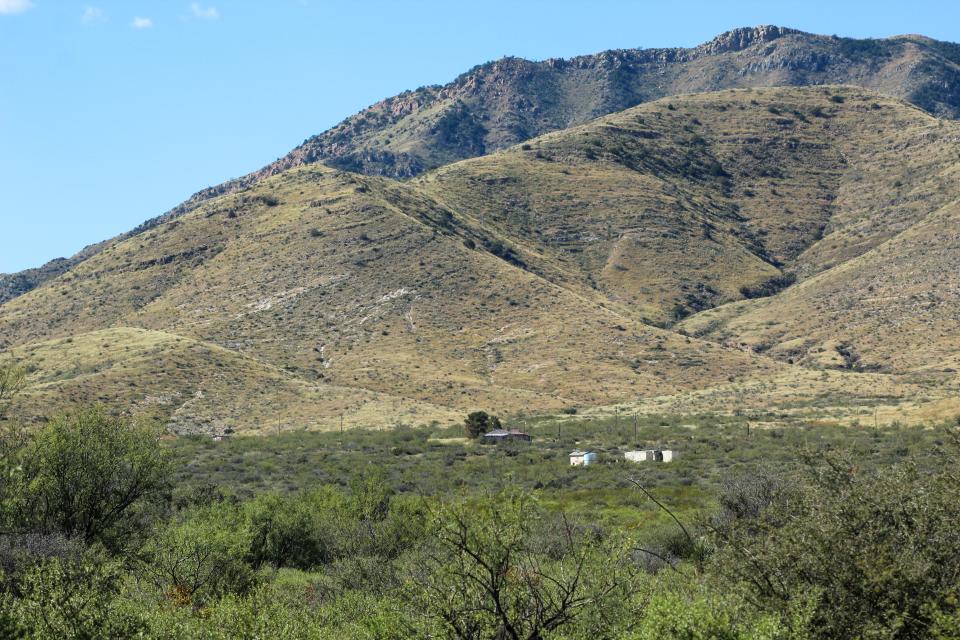
“People don’t tend to care about them until they are under the road they need to use or under their house,” Cook said.
He says it’s impossible to tie which operations are causing land to sink. Sometimes it takes decades of subsidence for fissures to open on the surface. The lag is a major concern because even if pumping slows in the area, the land will most likely continue to sink and the earth will continue to crack.
Cook believes the unsustainable pumping in the area has passed a point of no return. Since there is no river in the area, the only replenishing that occurs is through precipitation.
“All together everyone's taken a lot of groundwater out,” he said. “A lot of water is being taken out of the valley and we see a lot of subsidence in the valley so there’s a clear connection.”
Because subsidence changes the lay of the land, it can increase flood hazards during monsoon season. Natural drainage changes with subsidence so areas that never saw flooding before are now at a greater risk for damage caused by flooding.
And the opposite effect occurs when subsidence causes fissures on the surface, cutting off water flow and making access to groundwater even more difficult.
“As soon as you introduce this big crack, water just flows across the surface,” Cook said. “It pours into it, which means it's not going to continue past that crack, so areas that used to get water no longer get water.”
That also increases the risk of introducing toxins and pollutants to groundwater. Fissures become a dumping ground for tires, debris, manure, fertilizers and other items. The fissures are believed to extend to the water table which is what makes them so dangerous.

That contaminated water will not only seep into residential wells but also affect the local drinking supply, it will also be used to irrigate crops. This puts people outside of the basin at risk if they consume produce or dairy that was irrigated by contaminated water.
A 2021 study in a Wisconsin county, an area with an abundance of dairy farms much like Cochise County, found that cow manure was the leading cause of gastrointestinal illness with more than 230 cases. It found that fractured bedrock allowed manure to be introduced to the groundwater, ultimately ending up in residents’ drinking supply.
No studies like that one have been conducted in Arizona, but the Arizona Geological Survey lists manure as a risk to drinking water on its website.
Cook paints a picture of rainwater pushing through areas near the mega-dairy operations.
“Imagine,” he said, “a whirlpool of cow manure going down into the earth.”
Lawmakers balk: 'It's just a free-for-all': As water declines in rural Arizona, oversight faces resistance
Previous attempts were unsuccessful
Proposition 420 is not the first attempt to control water pumping in the two water basins.
Many residents did not want the state to manage groundwater, so less-ambitious efforts were taken to prevent government takeover.
In 2015, as the area struggled with the effects of depleting groundwater, a locally led initiative to manage groundwater and conserve it on farms emerged in the Willcox Basin.
“There were a number of farmers and some vintners who came together working with the Department of Water Resources to try to develop a different kind of management structure for the Willcox area,” Ferris said. “There was a great deal of concern among them that the groundwater was being depleted too quickly.”
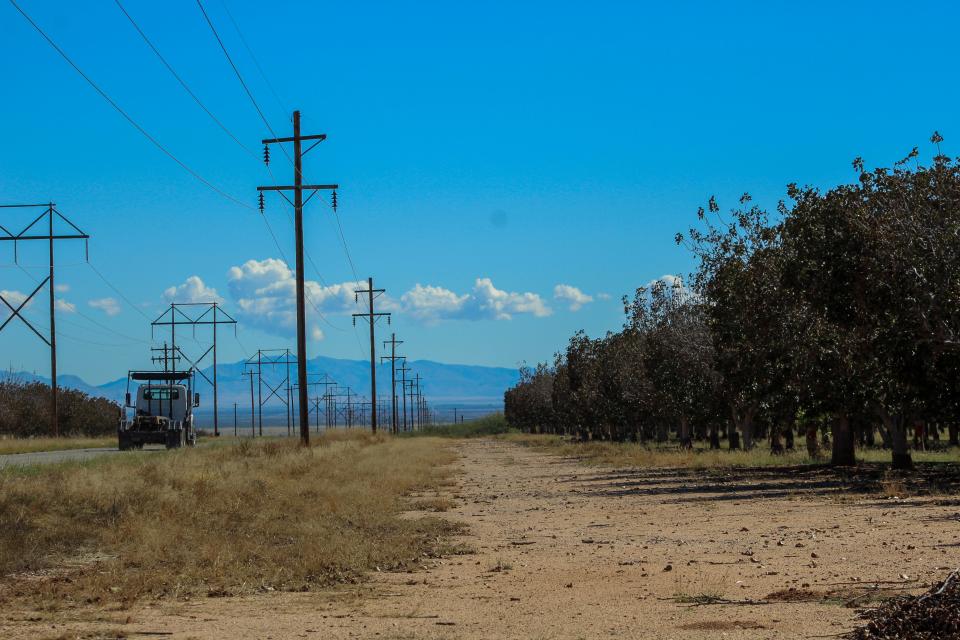
They came up with a plan and called it a groundwater conservation area. It allowed for local control and agreed-upon conservation levels.
It differed from an AMA because it allowed certain new uses of agriculture to come in if they were low-water users. It also allowed water rights to move around within the basins.
Farmers and vintners went to state legislators and told stories of spending more than $200,000 to deepen wells that were bone dry from overpumping. They were told by their own representative, Gail Griffin, to get consensus among all water users in the basin before it could be introduced as legislation.
The effort ultimately failed and the bill was never introduced. And because the state does not monitor wells in the area, there was no way to prove how much groundwater was being sucked up by large-scale farmers.
Griffin, a Republican who represents District 14 in the Arizona House of Representatives, is the chairperson of the Natural Resources, Energy and Water Committee, which can control bills regulating water.
She did not respond to a request from The Arizona Republic for an interview regarding the creation of an Active Management Area.
In 2020, two bills were introduced by Rep. Regina Cobb, R-Kingman, regarding the regulation of groundwater that failed in the Legislature. They were among 12 groundwater-related bills introduced in that legislative session.
One of the bills called for Rural Management Areas, which would have been established through a public hearing by a county board of supervisors. The second bill was to expand INAs in rural areas where they were not in place.
None of the bills ever got a floor vote in the House or Senate.
Opponents fear the effects of state control
Not everyone here wants an AMA.
The Rural Water Assurance is a group of Cochise County residents who oppose the creation of an AMA in the Willcox Basin. They are responsible for the “Local Water. Local Control” signs seen throughout the basin.
The group believes an AMA would take control out of residents' hands and place the future of the region in the hands of the governor and the governor's appointees.
But they don't oppose some form of management for water supply.
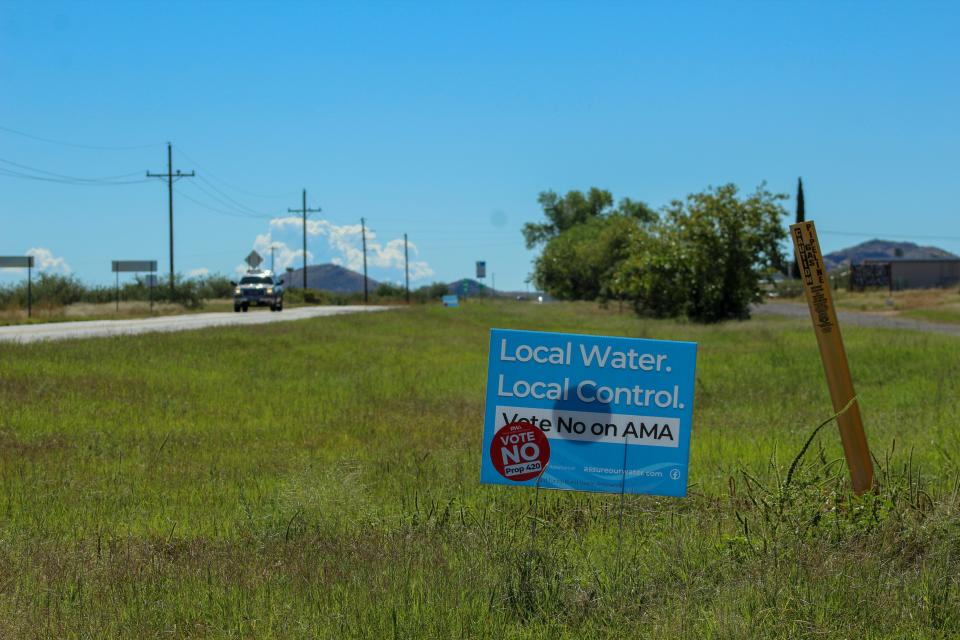
In a statement on their website, the group said, “We all agree that water is vital for our community but creating an Active Management Area is not the way.”
Proposed alternatives to an AMA, provided by RWA, include a modified INA, similar to the failed 2015 initiative, mountain recharge into the basins, and the creation of irrigation and residential water districts.
The group believes an AMA will slow or stop the expansion of farms, ranches and vineyards in the county and worries about the negative economic effects of an AMA.
The group's members have taken action to block voters from having a say in the creation of an AMA.
On Aug. 10, 2022, two members of RWA filed an election challenge, calling into question nearly all 2,218 signatures submitted by the Water Defenders.
Members Heather Floyd and Sonia Gasho alleged in the lawsuit that 2,094 of the signatures were deficient. They argued that signatures came from non-registered voters and did not match official voter registration.
Cochise County Superior Court Judge Laura Cardinal dismissed the challenges.
Floyd, RWA's chair, is the President of the Benson Chamber of Commerce and is a board member of the Arizona Center for Rural Leadership. Both groups are closely affiliated with the Arizona Farm Bureau.
Gasho, the alliance's treasurer, is the president of Cochise County Farm Bureau, the local affiliate of the Arizona Farm Bureau. Serving alongside Gasho on the board of the Cochise County Farm Bureau is Riverview LLP’s community outreach representative, Moira White. The address given by White in the Cochise County Farm Bureau annual report is the address of Riverview’s Coronado Dairy Farm.
At the time of the lawsuit challenging signatures, the organization had reported one $100 donation from a small ranch in Graham County as well as a $52 contribution made by Floyd herself.
RWA did not respond to emails or voicemails left by The Republic for comment.
Depleted resources: 'Our own survival is at stake': Arizona is using up its groundwater, researchers warn
Supporters say they are fighting misinformation
Supporters acknowledge an issue as complex as groundwater management will lead to misconceptions and face skeptics. Working to dispel rumors and false claims is one of the main goals of the defenders, who try to relay what they say are the facts to voters.
“There's a lot of denial, there's a lot of complacency,” Knot said. “I've been in both of those situations, so I'm not really pointing fingers at other people.”
One of the false claims surrounding the creation of an AMA is that residents will be taxed based on water use under the new designation.

“Some people keep saying there would be a pump tax,” Ferris said. “But there would not be because the law doesn't allow that in these new active management areas.”
Rabin says people tend to paint the idea of an AMA with a “broad brush.” She says people fear the AMA will shut down agriculture and negatively affect the economy.
“It's wrong to believe that we all stand to lose in this situation,” Rabin said. “A lot of smaller operations will be able to continue to thrive and people will be able to continue to enjoy their lives and their property out here.”
Ferris said one of the most common misconceptions about an AMA is that it is a prohibition on new wells. She says that's not the intention.
“It's just that when you do drill a well, you have to get a permit from the department and you have to meet well spacing standards,” she said.
Those standards prevent large new wells from unreasonably affecting an existing well. As agriculture has expanded rapidly in the area, they continue to drill wells that do not need permits, affecting the groundwater supply of smaller wells and causing them to run dry.
The AMA would attempt to prevent adverse impacts on small wells.
“There's a lot of stuff being pushed with the same rhetoric that you see in a lot of other situations,” Rabin said. “They believe that this is a big conspiracy from out of state, you know, or urban people are coming in and trying to impose it on everybody."
“The truth is, it was the people who live here that asked for this and got it,” she said. “They got the petition signed and got it on the ballot.”
Ferris, Knot and Rabin all worry about a future where voters do not approve the creation of an AMA. They use words like “grim” and “bleak” to describe what would happen to the area.
“If they cannot establish an AMA and agriculture keeps expanding, they will run out eventually,” Ferris said. “That area will run out of groundwater.”
Knot said people were waiting for action but just weren’t sure what could be done to resolve the issue.
“It was a matter of telling them what the petition was about and handing them the clipboard,” Knot said. “They were so worried about what has been happening here.”
Supporters of Proposition 420 believe time is sensitive as water is rapidly pumped from the ground without regulation. Without some form of management, water will eventually run out. And agriculture, the main economic driver of this rural county of 126,000, will not survive without it.

Some residents fear if the worst happens, the big dairy operations will load up their trailers with the cattle, the California nut growers will leave their trees to wither and the people who have lived here all along will be left with dry wells and drier land.
Jake Frederico covers environment issues for The Arizona Republic and azcentral. Send tips or questions to jake.frederico@arizonarepublic.com.
Environmental coverage on azcentral.com and in The Arizona Republic is supported by a grant from the Nina Mason Pulliam Charitable Trust. Follow The Republic environmental reporting team at environment.azcentral.com and @azcenvironment on Facebook, Twitter and Instagram.
Support environmental journalism in Arizona Subscribe to azcentral today
This article originally appeared on Arizona Republic: Cochise voters weigh water limits as wells run dry, lawmakers balk

